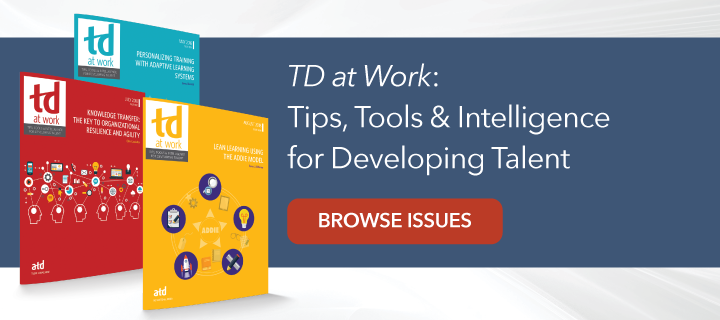We hear about the importance of soft skills—the human skills like active listening and emotional intelligence that can’t be replicated by technology. We don’t hear about persuasion and influence as much. The words can have a manipulative tone.
But persuasion, as Grace Torre stresses in “Persuade Effectively and Grow Your Influence,” is “a skill a person uses in the moment to change a point of view,” while influence tends to come from a “more enduring, sustained set of behaviors over time. Although that can include actively persuading others, influencing tends to be less overt while achieving equally successful outcomes.”
When Do You Need These Skill Sets?
Think of all the individuals and situations talent development professionals need to persuade and influence:
- Managers, to encourage them to support their direct reports with training and development opportunities
- Senior leaders, to urge them to provide a sufficient budget for L&D
- Subject matter experts, to inspire them to help develop instructional materials to change behaviors of learners
- Clients, to help them understand that their challenges may or may not be solved through training
How Do You Use These Skill Sets?
What does persuasion look like in action? You persuade others when you:
- Explain the “what’s in it for me,” perhaps highlighting to a stakeholder how a development opportunity will help direct reports grow, do their jobs more efficiently, and be more engaged.
- Include others in your solution or idea, asking questions like “Do you think this opportunity would help your team members?” and “How could this help your team more?”
- Use data to make your case, researching studies or presenting numbers that indicate, for example, that individuals who are offered growth opportunities are more likely to stay with an organization.
- Compromise when needed, taking steps such as working with a manager to delay training a month until a large project has been completed by the team.
Despite thinking ahead to your audience and what tactic is the best one to take given the situation, be ready for potential pushback when you use persuasion. As Torre points out, it is critical to use your persuasion and influencing skill sets ethically. Persuasion and influence are not about being pushy or using your title or place in the organization to make someone do something.
How Do You Make Your Point?
Persuasion and influence are more than just what you say—they’re also how you say it. Use emotional intelligence skills, which are based on both self and others, to think in terms of self-awareness and being socially aware for favorable relationship management.For example, the end of the day when a senior leader heads out the door to pick up her kids isn’t the right moment to use persuasion about your L&D budget. If you see on a person’s face that they are having a bad day, don’t casually initiate a conversation in the office kitchen to influence their opinion about training design.
If you’re having a conversation with a stakeholder and receive pushback, being adept at self-management means you don’t let the disagreement rattle you or cause you to raise your voice.
As Torre emphasizes, “No matter how you decide to pitch your idea, remain respectful of other people’s time, questions, and attitudes. Do your best to bring people in by communicating clearly and with an attitude of inclusivity.”
Talent development professionals persuade and influence people every day. Embrace these tactics to further your L&D program and your whole organization.




